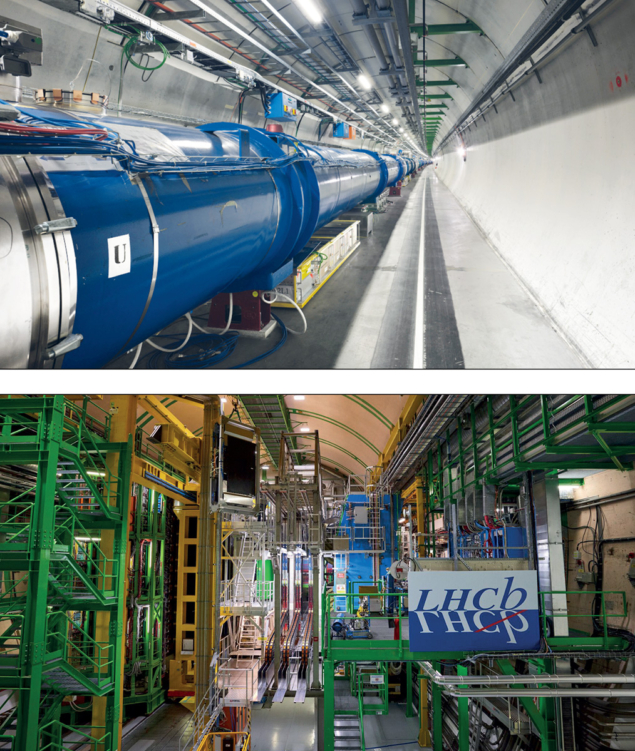
Following its year-end technical stop (YETS) beginning on 28 November 2022, the LHC is springing back to life to continue Run 3 operations at the energy frontier. The restart process began on 13 February with the beam commissioning of Linac4, which was upgraded during the technical stop to allow a 30% increase in the peak current, to be taken advantage of in future runs. On 3 March the Proton Synchrotron Booster began beam commissioning, followed by the Proton Synchrotron (PS).
In the early hours of 17 March, the PS sent protons down the transfer lines to the door of the Super Proton Synchrotron (SPS), and the meticulous process of adjusting the thousands of machine parameters began. Following a rigorous beam-based realignment campaign, and a brief interruption to allow transport and metrology experts to move selected magnets, sometimes by only a fraction of a millimetre, SPS operators re-injected the beam and quantified and validated the orbit correction ready for injection into the LHC. Right on schedule, on 28 March the first beams successfully entered the LHC. Thanks to very fast threading, both beams were circulating the same day, even producing first “splash” events in the detectors. As the Courier went to press, the intensity ramp-up was under way. Collisions in the LHC are expected to commence by the end of April, heralding the start of a relatively short but intense physics run that is scheduled to end on 30 October.
Refinements
Among many improvements to the accelerator complex made during the YETS, four modules in the SPS kicker system were upgraded to reduce the amount of heat deposited by the beam, and new instruments were installed in the LHC tunnel. These include the beam gas curtain, which will provide 2D images of the alignment of the beams to make data-taking more precise. Ten years in the making, the device was designed for the high-luminosity upgrade of the LHC (HL-LHC) as part of a collaboration between CERN, Liverpool University, the Cockcroft Institute and GSI.
“It’s a challenging year ahead, with the 2023 run length reduced by 20% for energy cost reasons,” says Rende Steerenberg, head of the operations group. “But we maintain the integrated-luminosity goal of 75 fb–1 by enhancing the beam performance and maximising beam availability.”
To cope with the higher luminosities during Run 3, and to prepare for a further luminosity leap at the HL-LHC beginning in 2029, many upgrades to the four main LHC experiments took place during Long Shutdown 2 (LS2) from 2019 to 2022. While the bulk of HL-LHC upgrades for ATLAS and CMS will take place during LS3, beginning in 2026, the ALICE and LHCb detectors underwent significant transformations during LS2. In the final weeks leading to the LHC restart, the LHCb collaboration completed the last element of its Upgrade 1 – the upstream tracker.
This advanced silicon-strip detector, located at the entrance of the LHCb bending magnet, allows fast determination of track momenta. This speeds up the LHCb trigger by a factor of three, which is vital to operate the newly installed 40 MHz fully software-based trigger. The new tracker will also improve the reconstruction efficiency of long-lived particles that decay after the vertex locator (VELO), and will provide better coverage overall, especially in the very forward regions. It is composed of 968 silicon-hybrid modules arranged in four vertical planes to handle the varying occupancy over the detector acceptance. A dedicated front-end ASIC, the “SALT chip”, provides pulse shaping with fast baseline restoration and digitisation, while nearby detector electronics implement the transformation to optical signals that are transmitted to the remote data-acquisition system in LHCb’s new data centre. Institutes from the US, Italy, Switzerland, Poland and China were involved in designing, building and testing the upstream tracker. Assembly began in 2021 and intensive work took place underground throughout the recent YETS, so the device installation was successfully completed by cavern closure on 27 March.
Under pressure
However, earlier in the year, there was an incident that affected another LHCb subdetector, the VELO. This occurred on 10 January, when there was a loss of control of the LHC primary vacuum system at the interface with the VELO. At the time, the primary and secondary vacuum volumes were filled with neon as the installation of the upstream tracker was taking place. A failure in one of the relays in the overpressure safety system not only prevented the safety system from triggering at the appropriate time, but also led to an issue with the power supply that supports some of the machine instrumentation, causing the pressure balancing system to mistakenly pump on the primary volume. The subsequent pressure build-up went beyond specification limits and led to a plastic deformation of the mechanical interface – an ultrathin aluminium shield called the “RF box” – between the LHC and detector volumes. The RF box is mechanically linked to the VELO and a change in its shape affects the degree to which the VELO can be moved and centred around the colliding beams.
To minimise any risk of impact on the other LHC experiments, the LHCb collaboration will wait until this year’s YETS to replace the RF box. In the meantime, the collaboration has been developing ways to mitigate the impact on data-taking, explains LHCb spokesperson Chris Parkes of the University of Manchester: “Initially we were very concerned that the VELO could have been damaged, but fortunately this is not the case. After much careful recovery work, we will be able to operate the system in 2023, and after the RF box is replaced, we will be back to full performance.”







